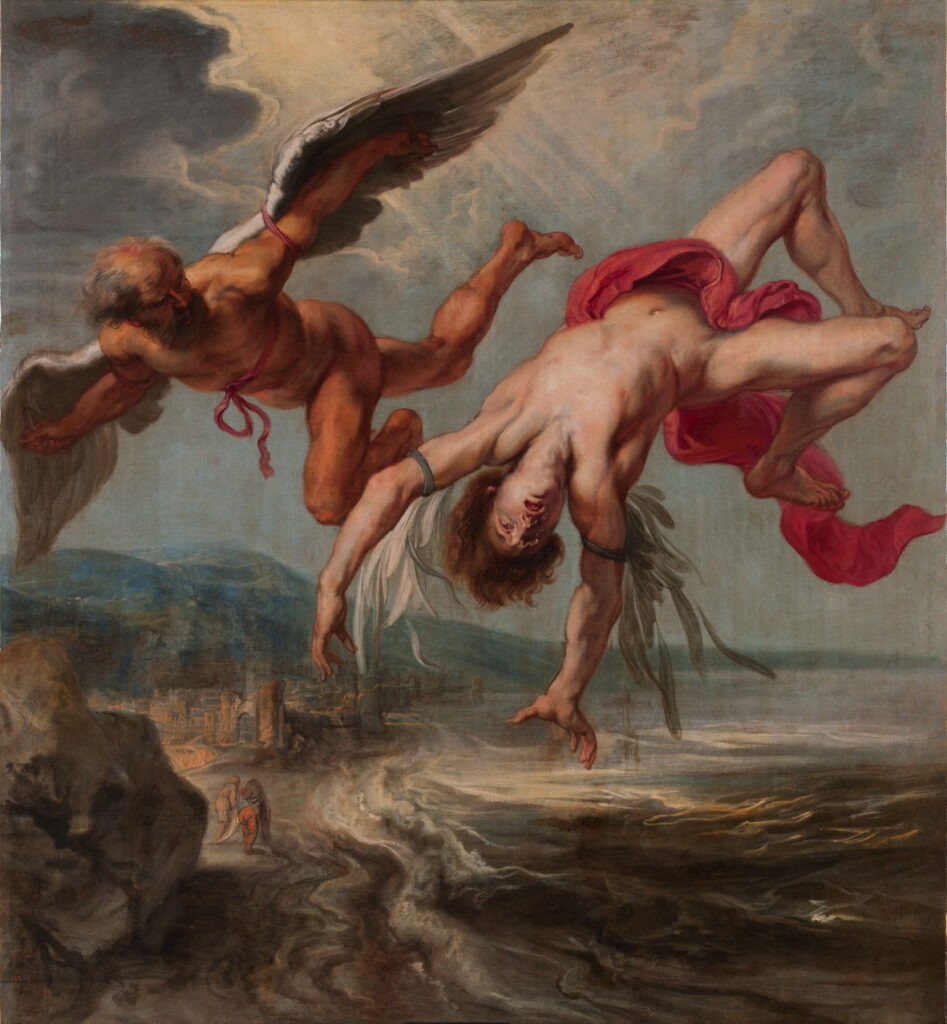Reading visual art: 144 Human flight

It seems that humans have always wanted to fly like the birds, although it’s clear that few birds have ever wanted to walk far on two legs. As is often the case, our aspiration has been transformed into stories, among the oldest being that of Daedalus and his son Icarus. The father was artificer and master craftsman to King Minos of Crete. After creating the Labyrinth, in which the Minotaur was kept, father and son were effectively imprisoned on the island, and tried to escape by flying with wings constructed from feathers held together by wax.
Charles Paul Landon (1760–1826), Icarus and Daedalus (1799), oil on canvas, 54 × 43.5 cm, Musée des Beaux-Arts et de la Dentelle d’Alençon, Alençon, France. Wikimedia Commons.
Charles Landon’s Icarus and Daedalus (1799) shows the moment that Icarus launches in flight from the top of a tower, his arms held out and treading air with his legs during this first flight. Daedalus stands behind, his arms still held horizontally forward from launching Icarus.
The pair flew away successfully, but Icarus grew over-adventurous, flying too high and close to the sun, which melted the wax holding his wings together. He then plunged to his death in the Aegean Sea.
Jacob Peter Gowy (c 1615-1661), The Fall of Icarus (1635-7), oil on canvas, 195 x 180 cm, Museo del Prado, Madrid. Wikimedia Commons.
His fatal downfall is shown best in Jacob Gowy’s Fall of Icarus from 1635-7, a conclusion that should deter all but the most foolhardy from trying to fly. Later stories thus show humans flying on mythical beasts with wings, like the hippogriff in Ariosto’s Orlando Furioso.
Louis-Édouard Rioult (1790–1855), Roger Rescues Angelica (1824), oil on canvas, 227 x 179 cm, Musée du Louvre, Paris. Wikimedia Commons.
Louis-Édouard Rioult’s Roger Rescues Angelica from 1824 shows the pair flying away after he had rescued her from the jaws of an orc, here left somewhere beneath them, as Ruggiero’s mission is successfully accomplished.
Salvador Tusell (fl 1890-1905), Illustration for ‘El ingenioso hidalgo Don Quijote de la Mancha’ (c 1894), watercolour after Gustave Doré, dimensions not known, Fondo Antiguo de la Biblioteca de la Universidad de Sevilla, Seville, Spain. Wikimedia Commons.
Even Cervantes’ Don Quixote, together with his long-suffering squire Sancho Panza, are duped into believing that they flew on a horse, as shown in Salvador Tusell’s illustration from about 1894, based on Gustave Doré’s fine series of prints.
As mythical flying beasts have ceased to be credible, the forces at work in human flight have grown darker.
Mikhail Vrubel (1856–1910), Flight of Faust and Mephistopheles (1896), oil on canvas, 290 x 240 cm, State Tretyakov Gallery, Moscow, Russia. Wikimedia Commons.
In Goethe’s Faust it’s Mephistopheles himself who takes his victim into the air, as painted by Mikhail Vrubel in his Flight of Faust and Mephistopheles from 1896. Here Vrubel uses small and sometimes tiled patches of flat colour, outlined in black, to model the figures, similar to a style adopted by many of the artists who illustrate modern graphic novels.
If it’s not the Devil himself who does the flying, then it’s one of the many witches that serve as his acolytes.
Fritz Roeber (1851-1924), Walpurgis Night Scene from ‘Faust’ (c 1910), oil on canvas, 186 x 206 cm, Museum Abtei Liesborn, Wadersloh, Germany. Wikimedia Commons.
Fritz Roeber’s Walpurgis Night Scene from ‘Faust’ from about 1910 shows this later scene, with Gretchen, Mephistopheles in red, and Faust surrounded by flying witches holding pitchforks.
Francisco Goya (1746–1828), Witches’ Flight (1798), oil on canvas, 43.5 x 30.5 cm, Museo Nacional del Prado, Madrid, Spain. Wikimedia Commons.
Francisco Goya’s Witches’ Flight shows three witches levitating in the air while carrying a naked body, which they appear to be exorcising. Below them are a donkey and another two human figures, one shrouded in a white sheet to cover their eyes, the other lying on the ground covering their ears, a possible reference to Goya’s own deafness and tinnitus when he painted this in 1798.
The Age of Enlightenment brought a more physical and realistic approach to human flight, first using hot air balloons.
Julius Caesar Ibbetson (1759–1817), George Biggin’s Ascent in Lunardi’s Balloon (1785-88), media and dimensions not known, Neue Pinakothek, Munich, Germany. Image by Ad Meskens, via Wikimedia Commons.
In the early eighteenth century, Europeans started experimenting with hot air balloons, and during the autumn of 1783 the Montgolfier brothers in France began to make the first human ascents using them. The British remained sceptical of the safety and merits of this French advance, and it took George Biggin’s Ascent in Lunardi’s Balloon to break the ice for them, an event painted here in 1785-88 by the wonderfully named Julius Caesar Ibbetson.
Jules Didier (1831-1892) and Jacques Guiaud (1811-1876), Departure of Gambetta in the Balloon ‘Armand-Barbès’ on 7 October 1870 (c 1870), media and dimensions not known, Musée Carnavalet, Paris. Wikimedia Commons.
One of the more famous balloon flights made from Paris is shown in Jules Didier and Jacques Guiaud’s painting of the Departure of Gambetta in the Balloon ‘Armand-Barbès’ on 7 October 1870 (c 1870), during the Franco-Prussian War.
By the time the Prussians had encircled Paris, a delegation from the French government had been sent to Tours, leaving Léon Gambetta, Minister of the Interior, trapped in the city. He arranged to be flown from the foot of Montmartre in a balloon filled with coal-gas, escaping on 7 October 1870. His balloon, named Armand-Barbès, was one of over sixty being used to transport mail and carrier pigeons from and to Paris at the time, giving an idea as to how popular ballooning had become.
Pál Szinyei Merse (1845–1920), The Balloon (1878), media and dimensions not known, Magyar Nemzeti Galéria, Budapest, Hungary. Wikimedia Commons.
One of the few paintings of the following years showing ballooning is that of the Hungarian realist Pál Szinyei Merse, The Balloon from 1878.
Then in the summer of 1909, the Frenchman Louis Blériot became the first person to fly an aircraft across the Channel, from France to England.
H. Delaspre (dates not known), The Channel Flight. Blériot, July 25th 1909 (1909), chromolithograph, dimensions not known, United States Library of Congress, Washington, DC. Wikimedia Commons.
H. Delaspre’s chromolithograph of The Channel Flight. Blériot, July 25th 1909 (1909) is one of the better prints produced at the time. The rest is aviation history.
In tomorrow’s article, I’ll consider divine flight.



